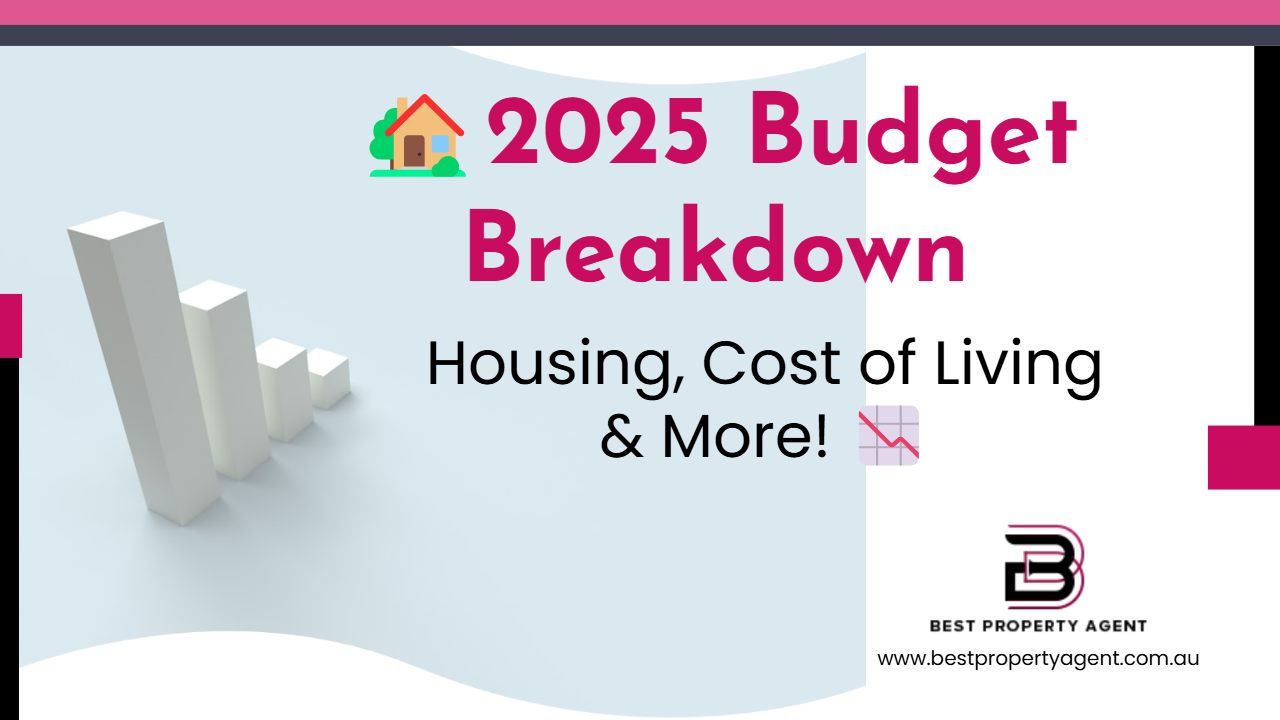The 2025 Federal Budget: What It Means for Housing, Cost of Living, and Infrastructure
As the Australian government unveils its 2025 Federal Budget, all eyes are on Treasurer Jim Chalmers as he lays out the financial roadmap for the year ahead. With cost-of-living pressures mounting and the next federal election looming, the budget aims to provide relief to households while investing in long-term infrastructure and housing solutions.
At BestPropertyAgent\we keep a close eye on the property market and government policies that shape it. This year’s budget is particularly significant for homebuyers, investors, and renters alike. Here’s a deep dive into what the 2025 budget means for the housing sector and beyond.
Housing Measures: More Support for First-Home Buyers
One of the biggest takeaways from this year’s budget is the continued push to make homeownership more accessible, particularly for first-home buyers.
-
- $800 Million Boost for the Help to Buy Scheme
The government is injecting an additional $800 million into the Help to Buy shared equity scheme, bringing the total funding to $6.3 billion. This program allows eligible buyers to purchase a home with as little as a 2% deposit, while the government contributes up to 40% of the property’s value.
- $800 Million Boost for the Help to Buy Scheme
-
- Higher Income and Property Price Caps
To expand accessibility, income limits have been raised from $90,000 to $100,000 for individuals and $120,000 to $160,000 for couples and single parents. Additionally, property price caps have been increased, allowing buyers to access homes in more desirable areas.
- Higher Income and Property Price Caps
-
- Investment in Prefabricated and Modular Housing
The government is allocating $49.3 million to support prefabricated and modular housing projects, a move that could significantly cut construction times and make homeownership more affordable.
- Investment in Prefabricated and Modular Housing
With home prices continuing to climb in key cities, these measures aim to bridge the affordability gap and speed up home construction to meet growing demand.
Cost of Living Relief: Energy and Healthcare Benefits
With inflation still a pressing concern, the government is rolling out initiatives to ease financial strain on households.
-
- $150 Energy Bill Rebate
Households will receive $150 off their energy bills through an extended $1.8 billion energy relief package, helping to offset rising power costs.
- $150 Energy Bill Rebate
-
- Cheaper Healthcare and Medicine
-
- $8.5 billion will be invested in increasing bulk-billed GP visits, allowing more Australians to access affordable healthcare.
-
- $689 million is allocated to reduce the cost of Pharmaceutical Benefits Scheme (PBS) medications to just $25 per prescription.
-
- $644 million will be used to open 50 new Medicare urgent care clinics.
-
- $570 million is earmarked for women’s health initiatives, particularly reproductive health and menopause support.
-
- Cheaper Healthcare and Medicine
These measures reflect a strong focus on healthcare affordability and accessibility, a key concern for Australian families.
Infrastructure Investments: Billions for Roads and Rail
Infrastructure spending is a key highlight of this year’s budget, with major funding directed at crucial projects nationwide.
-
- $7.2 Billion for the Bruce Highway Upgrade
Queensland drivers can look forward to improved road conditions and reduced congestion with a major investment in Bruce Highway upgrades.
- $7.2 Billion for the Bruce Highway Upgrade
-
- $2 Billion for Melbourne Airport Rail Link
After years of delays, an additional $2 billion has been allocated to the Melbourne Airport train project, bringing the total federal investment to $7 billion.
- $2 Billion for Melbourne Airport Rail Link
-
- $1 Billion for Western Sydney Rail Corridors
In NSW, $1 billion will be used to secure future rail corridors linking Western Sydney to the Macarthur region, improving connectivity and travel efficiency.
- $1 Billion for Western Sydney Rail Corridors
These projects are set to create thousands of jobs and improve transport networks, benefiting commuters and businesses alike.
The Bigger Picture: What This Budget Means for Property Investors
For property investors, the budget presents a mix of opportunities and challenges:
-
- Higher government spending on housing could stabilize rental demand, as more affordable homes enter the market.
-
- Infrastructure projects drive up property values in key regions, making strategic investment crucial.
-
- Inflation control efforts may impact interest rates, potentially affecting mortgage affordability.
Final Thoughts: A Budget Focused on Relief and Growth
The 2025 Federal Budget is a clear response to the cost-of-living crisis, with targeted relief for households while investing heavily in housing and infrastructure. For first-home buyers, investors, and renters, the expanded Help to Buy scheme and modular housing investments are welcome news. Meanwhile, cost-of-living measures such as energy rebates and healthcare subsidies aim to provide much-needed financial relief.
As property experts, we’ll continue monitoring how these changes impact the market and provide insights to help you make informed real estate decisions. If you’re looking to buy, sell, or invest, now is the time to stay ahead of the game.
For the latest updates on the property market and government policies, stay tuned to BestPropertyAgent
Need Help Navigating the Market?
Get in touch with our expert property agents today for personalized advice and market insights tailored to your needs. Let’s turn your real estate goals into reality!
Energy Bill Rebate: Relief for Australian Households
As part of the 2025 Federal Budget, the government has announced an energy bill rebate aimed at easing financial pressure on households struggling with rising power costs.
How Much is the Rebate?
Eligible households will receive $150 off their energy bills through an extended $1.8 billion energy relief package. This rebate is designed to provide immediate savings and help Australians manage the ongoing cost-of-living challenges.
Who is Eligible?
While full eligibility details will be confirmed when the policy is enacted, the rebate is expected to be available to:
- Low- and middle-income households
- Pensioners and concession cardholders
- Recipients of government benefits such as JobSeeker and Age Pension
Why is This Important?
Energy prices have been a major concern for Australians, with power costs rising due to inflation and global supply chain issues. By extending energy bill support, the government aims to:
- Provide relief to struggling households
- Reduce financial stress ahead of the next federal election
- Support economic stability by keeping essential costs manageable
How to Claim the Rebate?
Households do not need to apply separately. The rebate will likely be automatically applied to electricity bills, similar to last year’s $300 relief package. More details will be provided by energy providers and government agencies as the program rolls out.
This initiative, alongside healthcare subsidies and housing support, demonstrates the government’s commitment to addressing the cost-of-living crisis in Australia. Keep an eye on further announcements to see how this rebate could benefit you!
Cheaper Healthcare and Medicine: Budget 2025 Brings Relief for Australians
The 2025 Federal Budget has placed a strong focus on making healthcare more affordable, ensuring Australians can access essential medical services without financial strain. With rising healthcare costs impacting families nationwide, the government has introduced key initiatives to lower medical expenses and improve access to care.
Key Healthcare Budget Measures
✅ $8.5 Billion for Bulk-Billed GP Visits
- Increased funding will expand bulk-billing incentives for doctors, making it easier for Australians to visit GPs without out-of-pocket costs.
- This measure aims to encourage more doctors to offer bulk-billed consultations, particularly in regional and lower-income areas.
✅ $689 Million to Reduce Medicine Costs
- The government will cut the cost of medications listed under the Pharmaceutical Benefits Scheme (PBS) to just $25 per prescription.
- This means Australians will pay less for essential medicines, reducing financial pressure on families, seniors, and individuals with chronic conditions.
✅ $644 Million for 50 New Medicare Urgent Care Clinics
- To reduce strain on emergency departments, 50 new Medicare Urgent Care Clinics will be established across the country.
- These clinics will offer bulk-billed urgent medical care, ensuring Australians can access treatment for non-life-threatening conditions without long wait times.
✅ $570 Million for Women’s Health Initiatives
- A dedicated women’s health package will focus on reproductive health, menopause care, and maternal health services.
- This investment aims to improve access to specialist care and affordable treatments tailored to women’s healthcare needs.
Why This Matters?
With rising living costs, access to affordable healthcare is more important than ever. These budget measures aim to:
✔️ Reduce financial barriers to medical care
✔️ Make essential medications more affordable
✔️ Improve healthcare access for women and families
✔️ Ease pressure on hospitals and emergency services
What’s Next?
These initiatives will roll out over the next year, with further details expected from Medicare and PBS providers. If you rely on prescription medicine or need medical care, these budget changes could mean significant savings for you and your family.
Stay updated with BestPropertyAgent.com.au for more insights on how the 2025 budget impacts your cost of living!
Disclaimer:
This article is intended for informational purposes only and does not constitute financial, legal, or investment advice. While we strive to ensure accuracy, government policies and financial conditions may change. We recommend consulting a financial advisor or property expert before making any real estate or financial decisions. BestPropertyAgent.com.au does not take responsibility for any decisions made based on this content.




Leave a Reply